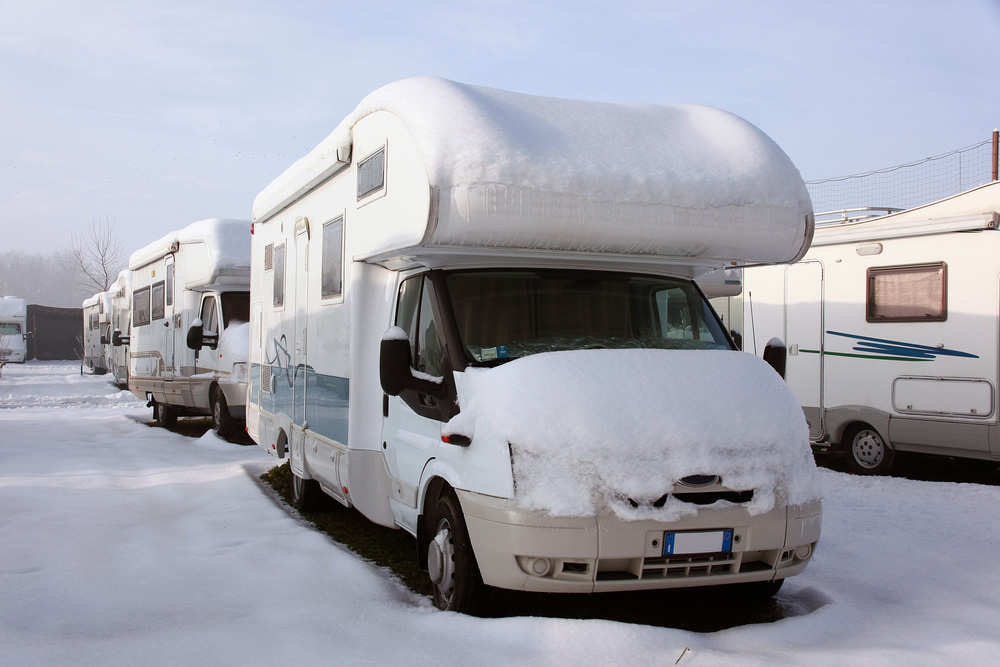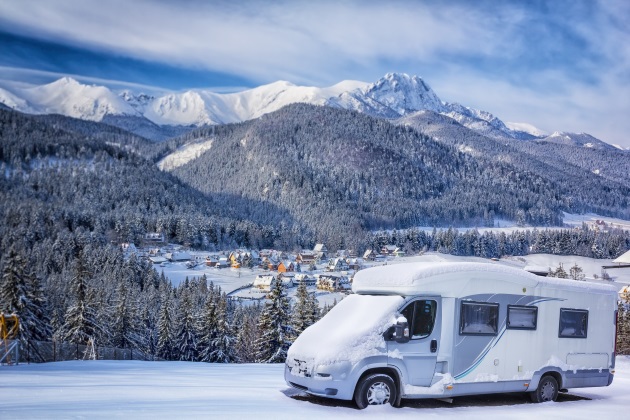Having an RV means you can travel anywhere in style and with comfort in mind. However, the fact that you can travel all over means you may find yourself in cold climates. There are a few things to keep in mind when operating an RV in the winter.
Most importantly, your pipes, if cold enough, may freeze if not taken proper care of. Using jugs of water is a better option to help keep your pipes unfrozen. If you’re storing your RV instead of using it during the winter, make sure you block all vents and holes to dissuade critters from making your RV their winter home. You can install curtains to help prevent sun damage to the furniture inside your RV.
 Source: extraspace.com
Source: extraspace.com
What Does it Mean By ‘Winterizing’ an RV?
Winterizing an RV is the process of preparing your RV for the winter, whether that means for storage or use. Winterizing is prepping the otherwise typical RV to withstand extreme temperatures or elements present during the winter. It entails making sure your RV is capable in the winter, both inside and out.
While your RV may be perfectly capable during the warmer months, few factors change during the colder season. Winterizing your RV ensures that you can travel or store your RV safely during this time without worry or concern.
Why is Winterizing an RV Crucial?
Winterizing your RV is crucial as outside factors can quickly ruin your vehicle, both interior and exterior. When the temperatures drop very low, things begin to freeze, and specific aspects of your RV may not work efficiently. If you don’t winterize your RV beforehand, you may find yourself with a hefty bill. If you plan on camping during the winter, you want your experience to be enjoyable.
The exterior of your RV is crucial to winterize as well. The harsh elements from the winter can cause a great deal of strain on the outside of your vehicle. Winterizing your RV ensures that it lasts as long as possible and continues looking brand new.
Steps to Winterize Your RV
Winterizing your RV can be a lengthy process. Completing the steps efficiently and thoroughly is in your best interest, as your RV will fare much better.
- One of the first steps to winterizing your RV includes sealing your vents and installing curtains to maintain heat inside the cabin. If you plan on taking your RV out during the winter, this ensures that the most heat remains inside the cabin as possible. If you plan to store the RV, this ensures the sun does not damage any furniture inside.
- An important step for those looking to store their RVs during the winter is to defrost your freezer and empty your pipes. Ensuring the freezer is empty and completely dried out will ensure it works properly again in the warmer months.
- After emptying the pipes of water, you lessen the risk of freezing and exploding. Many people go without plumbing for the winter season and use bottled water instead. This can be a safer option as if temperatures drop too low; you may not be able to fix your frozen pipes,
- It would help if you opened all doors and cabinets inside the RV to ensure heat can circulate. In a similar sense, you should shut off all appliances before storing them. If you plan on storing your RV all winter, turning off all devices and prepping the interior is a must, as leaving them on can cause safety hazards.
- Another step in winterizing your RV is sealing all vents and small openings. The process of closing all entrances is a great way to keep both the weather and the animals out. Little critters such as chipmunks and squirrels may find their way into your RV during the winter months if not properly sealed.
- Sealing any entrances is a crucial process as it keeps your RV able to withstand low temperatures and wandering critters. If unsealed, the weather, such as snow, rain, and other elements, may seep into your vents and ruin the interior. This can be a costly lesson in learning how to winterize properly.
- For the exterior, the outdoor elements can ruin the outside of your RV. Washing and thoroughly cleaning the exterior is a part of the winterizing process to ensure your RV has a long life. Make sure you clean the entire body, including the roof, before storing it for the winter.
- Purchasing a cover for your RV can also do wonders to protecting the exterior and keeping it safe. If you have the funds, consider purchasing a cover to use throughout the colder months when your RV is not in use. Doing proper research and finding a cover that works well in the winter months and fits your RV correctly are essential factors as well.
 Source: http://exclusive.multibriefs.com/
Source: http://exclusive.multibriefs.com/
Things Required for Winterizing
When thinking about winterizing, there are a few items you can pick up to help the process run smoothly. You can replace the water in your plumbing system with non-toxic antifreeze to keep it running efficiently during the colder months. Not all antifreeze options are the same, so make sure you do your research to find the best one for your RV.
Another required winterizing tool is vent covers to ensure your RV’s safety from both the temperatures and outside animals.
- More is always better – you’d rather have gone the extra mile to keep your RV safe than have done too little and risked ruining your vehicle
- Start preparing earlier than you think – it’s no fun waiting until the last minute then having to prep while temperatures are already freezing
- Don’t neglect the outside – the interior of your RV is talked about more frequently when discussing winterizing but don’t forget to take care of the outside as well
- Remember to drain any water from inside the RV – leaving any liquid inside runs the risk of freezing and exploding
- Things can change – you never know how cold exactly a winter season will be, so make sure you take the extra precautions to keep your RV safe
Bottom Line – Are You Ready to Drive an RV?
While you now know how to winterize your RV, don’t forget that driving one requires certain types of licenses depending on the state. Make sure you do your research depending on where you live and where you plan to travel to ensure that you’re legally driving your RV. Most licenses required for RV driving are either easy to obtain or are no different than your regular driver’s license.




